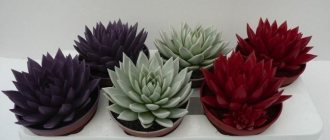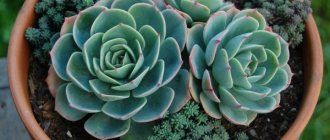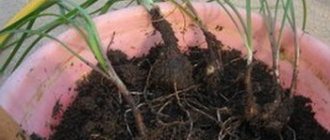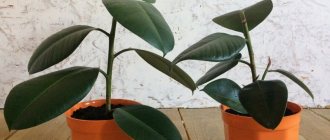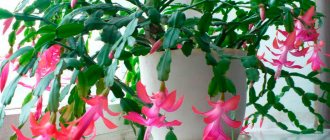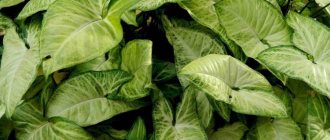general information
Echeveria is a perennial succulent and a close relative of the Crassula plant. In nature, it most often grows in Mexico, but in our country it is grown as a houseplant and for decorating alpine slides.
The small massive stem is almost indistinguishable under the dense rosette. Neat but fleshy leaves are collected into a kind of inflorescence, and for this feature Echeveria is nicknamed the stone rose. Most often, the leaves are oval, with a sharp tip.
Sometimes echeveria blooms, and does so very intensely and for a long time. Then it produces thin peduncles with many small bells. With proper care, you can achieve repeated flowering.
Photo: vkusnosushi.ru
Botanical description and photo
Echeveria Miranda is a perennial succulent plant. Latin name: Echeveria Miranda. The flower has oval leaves, pointed at the end. They are dense, gathered into a rosette like a rose flower. Average length – 25 cm, width – 15 cm.
The stem is inconspicuous, but sometimes grows up to 70 cm. The basal rosettes form a lotus shape. The foliage can be pink, lilac, silver or yellow. The plant never blooms. It differs from other types in shape, color, and ease of care.
Next in the photo you will see this plant:
Echeveria species
There are so many types of echeveria that they are classified according to dozens of characteristics. For example, by the size, shape or color of the leaves, by the type of root system, by sensitivity to light, by the structure of the rosette. Let's look at a few of the most common ones!
Agave echeveria
It really resembles a small agave, and also an open water lily bud. The leaves are red, and the intensity of the color varies depending on the time of year.
Photo: aloli.ru
hump-flowered echeveria
It is a bit like a tree in its structure with distinct branches. It is on these branches that large bluish rosettes of irregularly shaped leaves are formed.
Photo: oir.mobi
Echeveria Affinis
A very tiny succulent with very dark, almost black leaves. But when there is a lack of light, the compact fluffy rosette stretches out and brightens.
Photo: pinterest.ru
Metal-flowered echeveria
A very decorative appearance with an openwork edge of the leaves and an intense metallic tint. This echeveria hardly blooms at home, but it is good anyway.
Photo: landscapeportal.ru
Graceful Echeveria
This species does not have a main stem at all, and the rosette actually grows directly from the ground. The leaves are medium in size, up to 5 cm in length, and bluish-green in color. They are covered with thin fibers that cannot be gotten rid of.
Photo: distano.ru
Scarlet Echeveria
It is distinguished by the special shape of its leaves - hard, voluminous, with a sharp, prickly tip. Color – olive with burgundy and brown splashes.
Photo: fiftyflowers.ru
Echeveria Derenberga
This is a creeping species that is capable of growing with children no worse than a ground cover. The grayish leaves have a pink tint at the tips. This echeveria blooms early - by mid-spring with large yellow flowers.
Photo: public.fotki.com
Echeveria Lau
One of the most bizarre varieties with a thick trunk, equally thick peduncles and unusual buds. The entire plant, including the flowers, is covered with a waxy coating.
Photo: worldofsucculents.com
Stromantha (50 photos): types, planting and care at home
Features of growing at home. Briefly
| Temperature | In summer – 20-27 degrees, in winter – 10-15 degrees. |
| Air humidity | Low, does not require spraying. |
| Lighting | Echeveria at home needs bright lighting; a south or south-east window sill is suitable. |
| Watering | Moderate in summer - once a week, scanty in winter - once a month. |
| Priming | Light sand mixture, well permeable to air and moisture; substrate for succulents. |
| Feeding and fertilizer | During the growing season, apply fertilizer for cacti once a month. |
| Transfer | Young specimens once a year in the spring, adults - once every 3-4 years. |
| Reproduction | Daughter rosettes, leaf cuttings, seeds. |
| Features of cultivation | The leaves are very fragile; in summer it is useful to take the plant out into the fresh air. |
Echeveria care
Echeveria is an ideal succulent for beginners and for those who always forget about care. Regardless of the variety, it requires minimal human intervention for a long and comfortable life.
Temperature
The best summer temperature for echeveria is about 25 degrees, but in winter it easily tolerates much lower thermometer readings. 6-8 degrees is enough, and you shouldn’t increase them too much so that the socket doesn’t start to stretch.
Photo: zelenj.ru
Lighting
Echeveria needs a lot of light so that it grows a rosette neatly and beautifully. Moreover, this may well be direct sunlight. Perhaps some varieties should be shaded a little around noon on southern windows.
Photo: zen.yandex.ru
Watering
Echeveria is watered rarely and not very abundantly, otherwise the roots will begin to rot. Its leaves store enough moisture for dry periods, so it is always better to overdry than to overwater. We recommend watering the echeveria through a tray. There is no need to spray it either.
Photo: commons.wikimedia.org
The soil
Ready-made mixtures for succulents will solve all your problems. Or you can mix ordinary universal soil with sand and peat yourself.
Photo: zzseeds.com
Fertilizers and fertilizing
In the summer you can occasionally use fertilizer for succulents, but this is not fundamentally necessary. There is no need to fertilize the flowerpot too much, because the echeveria will begin to grow unevenly and become deformed.
Photo: komnatnyecvety.ru
Wintering
As we said, a cool, dry winter is desirable for echeveria. The fact is that at this time the plant is in dire need of light. And it is precisely because of this that it begins to deform. So it is better to ensure that Echeveria is in a kind of suspended animation until spring.
Photo: vseshokeri.ru
Transfer
In spring, echeveria is carefully replanted so as not to damage the leaves, and especially the plaque or fibers on them. At the same time, you need to inspect the roots for damage and rot, and, if necessary, treat them with charcoal. The flowerpot needs to be compact and shallow.
Photo: haworthias.ru
Pachistachis (50 photos): types, planting and care at home
Types of Echeveria and their main differences
Among the miniature species (up to 10 cm), the following common varieties can be distinguished:
- Echeveria graceful is a light green rosette of leaves and a peduncle of the same color with red-yellow flowers.
- Echeveria Derenberga - blooms with beautiful orange flowers, and its leaves attract attention with their red edges.
- Echeveria bristlecone is a miniature plant whose leaves are covered with white bristles.
Among the high ones, the most common are:
- Echeveria crimson - distinguished by a strong stem, at the top of which there is a rosette of pubescent leaves, blooms with red flowers with yellow edges.
- Echeveria humpback flower - the stem is very strong and can grow up to 65 cm in height.
The most frost-resistant is Echeveria glaucosa.
In addition to these species, nature and man have created other beautiful forms of echeveria.
Photo gallery: Elegant Echeveria and other popular varieties
In adulthood, Echeveria humpback flower grows up to 65 cm in height.
Echeveria crimson is distinguished by its large size and two-color leaves
Echeveria bristlecone - a cute rosette of leaves with white fluff
Echeveria Derenberg leaves have red edges.
Echeveria Runyon's leaves have intricately curved leaves.
Echeveria graceful is also called elegans. Echeveria gray will withstand even light frosts.
Reproduction and planting of echeveria
The most convenient way to propagate echeveria is by leaves and cuttings, and practically nothing is needed for this. The cuttings are immediately rooted in the ground without any additional steps. The leaves must first be dried for at least half a day, and then stuck into the ground in the same way. Within a week the roots will begin to grow.
For long-stemmed species, shoot tips can be used. And the squat ones reproduce well by children - basal rosettes. They just need to be carefully separated and planted.
Photo: design-homes.ru
What to do if a flower is affected by diseases or pests
Echeveria is very rarely affected by pests, but in most cases it is a mealybug, which damages the leaf blades and eats up the roots of the plant . Insect colonies look like dirty cotton wool on the leaves. They are removed with alcohol-soaked cotton swabs or washed off with soap suds. In difficult cases, the plant and soil are sprayed with insecticides, for example, Aktara and Fitoverm are suitable.
If you overwater the succulent or there is a fungal infection in the soil, it will begin to wither and rot . You can save the plant at the initial stage of infection by using Fitosporin or Trichodermin according to the instructions, but, unfortunately, it is usually possible to detect it only when it is no longer possible to help.
Pest and disease control
Succulents have strong immunity, and echeveria is no exception. Very rarely it is affected by aphids or mealybugs, and insecticides will help you here. But it is better to abandon traditional methods so as not to damage the leaves by mechanical influences.
Otherwise, everything depends on care. If the leaves turn black or become stained, it means they have been exposed to water or have a fungus. In any case, the problem is excessive humidity and low temperature. Use fungicides and stabilize conditions quickly.
Photo: st-georgerealestate.com
Schefflera (50 photos): types, planting and care at home
Similar flowers
The following species resemble Echeveria Miranda:
- Sempervivum from the Crassulaceae family has dense, small leaves collected in a rosette.
- Lotus - has a similar flower shape.
- Aeonium (tree-like succulent) - has a pink rosette and dark green shiny leaves.
- Haworthia (dwarf plant) - folds the foliage into a rosette.
- Aloe (succulent) - has a similar leaf shape, forming a rosette.
Echeveria Miranda is a popular houseplant that does not require complicated maintenance. It is easy to grow or propagate such a flower if you take into account the basic rules and recommendations. Attention should be paid to the temperature regime, the amount of watering, soil mixture, and fertilizing. With proper care, a stone rose will delight you with its beauty and long life.
Echeveria – photo
Only at first glance, echeveria may seem completely unremarkable and banal. But in fact, they are all special and unique!
Photo: pinterest.ru Photo: pinterest.fr Photo: mykaleidoscope.ru
Photo: tr.pinterest.com
Photo: commons.m.wikimedia.org
Photo: pinterest.ru Photo: pinterest.co.uk Photo: komnatnyecvety.ru
Photo: tripchik.ru
Photo: cvetkoffandbuketoff.ru
Photo: cactusgarden.ru
Photo: jdhager.wordpress.com
Photo: pinterest.ru
Photo: fastbox.su
Photo: aloli.ru
Photo: na-dache.pro
Photo: pixabay.com
Photo: gardenista.com
Photo: succycrafts.com Photo: succicrafts.com
Did you like the post? Subscribe to our channel in Yandex.Zen, it really helps us in our development!
Description of plants of the genus Echeveria
Succulents of the genus Echeveria were given their name by the French botanist Augustin Piram de Candolle in 1828. The venerable botanist was on an expedition to Central America in the company of the Mexican botanical artist Atanasio Echeverría and Godoy. The Frenchman was so impressed by Athanasio's artistic skill that he named one of the documented plant families after the artist. Thus, one of the most famous and widespread genera of succulents was named Echeveria.
Echeverias are considered one of the most beautiful succulents. They form attractive rosettes of succulent leaves and often resemble roses, water lilies or tousled lettuce. These are fairly small houseplants, but still very robust and easy to care for. You can forget to water them for a month without them wilting. Plants prefer desert conditions.
Photo of Echeveria in the botanical garden
The leaves come in a variety of colors from simpler greens to some really showy colors. As a rule, the leaves form a rosette that remains almost unchanged throughout life. Forming a rosette allows for maximum exposure to light sources, allowing plants to effectively capture and direct water down to the roots.
The Echeveria succulent plant grows well in both containers and garden beds. The variety and color of Echeveria plants provide wonderful tone and texture for mixed flower beds and containers. The leaves are fleshy and have a waxy cuticle on the outside; touching them can damage the skin of the leaf and leave marks. Often the leaves are colored. Echeveria grows slowly and usually does not exceed 30 cm in height or width.
Echeveria blossom
"Stone Rose" blooms in spring or summer. A long vertical or lateral peduncle becomes the point where lateral-type inflorescences consisting of small flowers appear. The shade of the buds is different. May be brown, red, orange-red or yellow. The petals are quite juicy. Based on how bright the lighting is, the color saturation of the flowers itself also changes. Those that form in the shade have yellowish hues, while those that form under ultraviolet rays have reddish colors.
How to grow?
Each type of echeveria has its own germination time. Some plants will produce sprouts within 20 days. Others can sit for 3 months and only then begin to grow. Therefore, it is important to be patient and provide your future green pet with decent care. Echeveria is not a capricious plant, but it requires special care.
It includes the following points:
- Temperature . For heat-loving echeveria, temperatures of +20°С – +27°С are considered optimal. The seeds can easily withstand heat up to +30°C. At night the temperature can drop to +18°C.
- Choosing a location . The southern plant loves light very much, but placing a greenhouse in direct sunlight is not recommended. During the germination and pipping of sprouts, diffused lighting is more suitable for the succulent. The greenhouse should be in a place protected from drafts. Even light gusts of wind can destroy a delicate plant.
- Watering . The soil must be moistened regularly. The soil should not be allowed to dry out. However, the culture should not be flooded. Stagnation of water will lead to rotting. It is recommended to water the soil daily and little by little.
When the plants reach a height of 2-5 cm and their leaves appear stronger, the seedlings can be transplanted into separate pots or planted in open ground.
In this article I wrote about echeveria. I really like Echeverias. I decided to grow them from seeds. I ordered the seeds twice. I had my first sowing in early December. I ordered the seeds from retailers in North West. I had eight types of echeveria, five seeds of each type. ECHEVERIA halbingeri San Joaquin, ECHEVERIA harmsii, ECHEVERIA cuspidata, Menchaca v gemmula, ECHEVERIA calderoniae, Echeveria Fimbriata, Eucalyptus cinerea, Echeveria setosa, Echeveria multicaulus. That is, there are 40 seeds in total. Echeveria seeds are very small; for example, in the photo are the seeds of one of the species.
Trying to separate different species from each other, I scatter the seeds in different rows on a damp surface. I use commercial soil for succulents with the addition of vermiculite and a small amount of fine sand. The container is located in a sealed greenhouse. I wet the surface by spraying as the soil dries. The first small sprout appeared a month later.
A few days later two more shoots appeared. The sprouts are very small. It is very difficult to care for such small seedlings. Their stems are thin. When spraying, lodging occurs. When the soil is wetted from below, the stems also lie down. I didn’t see any more sprouts, except for two dark, long stems. These sprouts, if they were Echeveria sprouts, eventually died. Echeveria seedlings grow too slowly, not increasing in size for a long time. In the end, I was left with only one, the very first seedling. Real leaves began to appear on it almost two months after germination.
After their appearance, the seedling began to grow faster. More than three months after the seeds germinate, echeveria looks like this.
Approximately two and a half months after sowing the seeds, two more sprouts appeared, similar to the first sprout that appeared. They are still growing just as slowly. Three months after sowing the seeds, two more sprouts appeared. These sprouts are larger and have darker-colored leaves.
It is clear that this is a different type of echeveria. These sprouts are growing faster; they have already outgrown the other two small sprouts. Thus, only seven echeveria seeds sprouted, perhaps two more, but I am not sure if these were echeveria. Currently, only five seedlings from the first planting are alive. Of these, only one plant has true leaves. This is what the remaining five seeds look like after the first sowing, four months after this sowing. After some time, only two plants remained. One of them is the very first of the seeds to germinate, and also one of the last to emerge from the seeds. I'm not sure that these plants will grow to adulthood.
I carried out the second sowing on February 6th. I also ordered different types of echeveria from the English online store.
There are 48 seeds. I sow in moist soil with the addition of fine sand, as written in the recommendations of this store. According to the information here, seed germination takes 1-6 months. Germination is not simultaneous. And so it happened. A month later, only one small sprout appeared. No matter how hard I tried to moisten the soil carefully, the small echeveria seedling died. After all, the soil has to be moistened so that other seeds can germinate. There are no more shoots yet, almost four months after sowing the seeds. They are not there even after almost a year.
The following conclusion can be drawn. Echeveria can be grown from seeds. But this is difficult to do. At least for me. Firstly, almost all of my seeds did not germinate. Apparently she did something wrong when sowing. Further, small seedlings of some species of Echeveria, very small in size, remain for a long time. It's difficult to preserve them. It is possible that you need to sow several seeds in different containers, so that there is different care for the crops of ungerminated seeds and for the seedlings that have already appeared. Personally, I will no longer try to grow Echeveria from seeds.
Ultimately, after a year, I only have one echeveria grown from seed. You can see about this echeveria cuspidata in this article.
How to plant?
Planting seeds is carried out according to the following algorithm:
- You need to take a thick sheet of paper, bend it in half, and pour seeds inside.
- This structure is brought to a container with a substrate and, tapping with a light stick, they begin to scatter the seeds into the ground.
- The raw materials are covered with a thin layer of sand (about 2 mm) on top.
- If the seeds are very small, then you don’t need to sprinkle them.
- The soil is thoroughly moistened with filtered water (the temperature of the liquid should be room temperature). To avoid washing away the seeds and causing them to sink deeper into the soil, it is recommended to water them with a spray bottle.
- After watering, cover the container with seedlings with a lid, cellophane film or glass.
Pros and cons of the method
Growing echeveria from seeds is one of the rarest methods of propagating rock roses . It is considered the most labor-intensive, so it is used extremely rarely. To grow strong and viable seedlings from small seeds, you need to take into account many nuances and have great patience.
However, this method also has a significant advantage. Only those echeverias that are already in your home collection can be grown with rosettes or leaves (you can learn about propagating echeveria by leaves here). What if you want to plant new exotic species? It is in this case that they resort to planting the plant with seeds.
